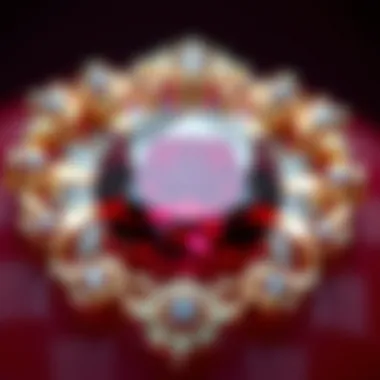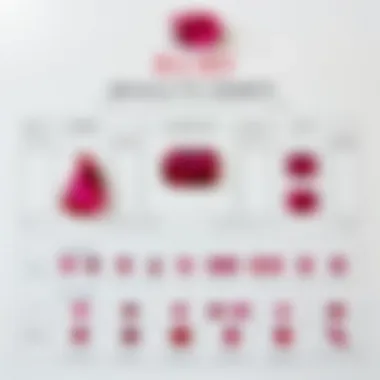Where to Buy a Ruby: An In-Depth Guide for Buyers


Intro
Many people have a fascination with gemstones, and rubies, in particular, are often considered the crème de la crème. Embodying passion, power, and luxury, these vibrant red stones capture the hearts of collectors and jewelry enthusiasts alike. This guide aims to navigate the intricate landscape of purchasing rubies, shedding light on essential aspects. From understanding what makes a quality ruby to the various avenues available for purchase, we'll cover everything in a straightforward manner.
Gemstone Overview
Description of the Gemstone
Rubies are a variety of the mineral corundum, with their striking red hue primarily attributed to chromium. They are known for their rarity and have long been associated with nobility and love. Unlike diamonds that come in various colors, rubies hold enormous value for their deep, rich shades—ranging from pale pink to an intense red, often referred to as "pigeon blood" in gemological terms.
Physical Properties
Rubies are rated on a scale of hardness, scoring a solid 9 on the Mohs hardness scale, making them just shy of diamonds as one of the hardest gemstones. Their physical attributes are quite remarkable, typically exhibiting a vitreous luster and clarity. However, inclusions can occasionally be noticed, which can add to a ruby's unique character. When searching for surpassing quality, look for the following:
- Color: The most vital element, with the most desirable being a vivid red color.
- Clarity: Refers to the absence of inclusions. While some inclusions are expected, fewer is better.
- Cut: Shapes range from oval to round—each affects how the stone reflects light.
- Carat Weight: Heavier stones are scarcer and therefore fetched at a premium price.
Rubies can be found in numerous cuts and settings, often used in everything from rings to necklaces, offering versatility that appeals to many aesthetes.
Healing Properties
Metaphysical Attributes
Beyond their physical beauty, rubies are often touted for their alleged metaphysical properties. They are said to inspire passion and vitality, believed to activate the root chakra and stimulate one's life force. Some enthusiasts claim that having a ruby on one’s person can enhance confidence and courage while also being beneficial for fostering emotional stability.
Common Uses in Holistic Practices
In holistic practices, rubies are commonly employed in various ways:
- Meditation: Many people incorporate rubies into their meditation routines to cultivate strength and energy.
- Crystal Grids: Combining rubies with other stones is thought to amplify their healing properties.
- Jewelry: Wearing ruby jewelry is believed not just to enhance aesthetics but also to harness healing energies.
With this knowledge at hand, you are better equipped to appreciate the intricate world of rubies, aiding you in making informed decisions. The next segments will delve into purchasing avenues, how to spot a fake, and the importance of ethical sourcing.
Understanding Rubies
When stepping into the world of gemstones, grasping the essence of rubies is nothing short of essential. Rubies are not merely beautiful stones; they're steeped in history and cultural significance, making them a treasure for gem enthusiasts and collectors alike. Knowing what makes a ruby special can significantly impact your purchasing decisions, ensuring you either find a perfect piece for yourself or make an informed investment.
Characteristics of Rubies
Rubies, known scientifically as corundum, boast a striking coloration that ranges from a delicate pink to a thrilling blood-red, known as pigeon’s blood. But it’s not just the color that counts; the saturation and hue can make a huge difference in value and aesthetic appeal. Other notable characteristics are:
- Clarity: Unlike diamonds, rubies often contain inclusions—these are tiny imperfections that can affect value. Yet, in many cases, inclusions may tell a story of the stone's origins.
- Cut: The facets of a ruby can either enhance or hinder its brilliance. An adept cut can bring life to the stone, allowing the color to dance in the light.
- Carat Weight: Larger rubies are considerably rarer than smaller ones, which can make a significant difference when it comes to price.
Understanding these characteristics helps buyers differentiate between quality stones and those that are less desirable.
Ruby Varieties
Not all rubies are created equal, and recognizing the different varieties can broaden one’s perspective:
- Natural Rubies: These gems are formed purely through geological processes. Natural rubies may also be heat-treated to enhance color or clarity, a common practice in the market.
- Synthetic Rubies: Created in labs, these stones share the same chemical makeup as natural ones but are typically less valuable. It’s a careful balance – while they are often flawless, they lack the deep, historical allure of their natural counterparts.
- Fancy Color Rubies: These come in various hues aside from red, such as purple and pink, and can spark a unique interest for collectors, though they are sometimes valued differently.
Knowing these distinctions aids buyers in navigating their choices effectively, elevating their understanding of the market.
Where Rubies Are Found


The pursuit of rubies requires an awareness of global locations renowned for producing this captivating gemstone. Key regions include:
- Myanmar (Burma): Renowned for the finest rubies globally; their rich, pigeon blood color stands as a benchmark in the gem world.
- Thailand: Historically a major player in the ruby market, known for producing stones with rich, vibrant colors.
- Sri Lanka: Home to a variety of corundum, including spectacular rubies often featuring unique inclusions.
- Madagascar: An emerging source, offering some beautiful rubies with interesting color ranges and lower prices compared to established sources.
Understanding these geographical connections can not only inform your choices but add depth to your appreciation of rubies, even enhancing conversations about their value and origin.
Market Overview
The ruby market is a fascinating landscape that attracts both casual buyers and seasoned investors. Understanding this market is crucial for making informed decisions when purchasing a ruby. Numerous factors come into play, from current trends and pricing to potential investment opportunities. This section aims to illuminate various aspects of the ruby market, helping readers grasp the dynamics involved.
Current Ruby Market Trends
At the heart of the ruby market lies an intricate web of trends that influence supply and demand. As of late, there’s been a notable resurgence in interest for colored gems, and rubies are catching the spotlight. The increasing popularity of sustainable and ethically sourced gemstones has shifted buyer preferences, prompting many vendors to adapt their inventory. Online platforms and social media are now showcasing these magnificent stones in ways that captivate potential buyers, especially among the younger demographic who value unique expressions in their jewelry.
For instance, more gemstone enthusiasts are leaning toward rubies that are sourced with transparency and integrity, as they align more with modern values. If you keep your ear to the ground, you’ll notice that certain shades, particularly those that reach a deep, blood-red hue, are becoming increasingly sought after. Consequently, the demand influences market prices, making it essential to understand these trends thoroughly.
Pricing Factors
Color
Color is paramount when pricing rubies. The vibrant red hues serve not only as a marker of quality but also dictate the stone's value in the market. A ruby that displays a uniform, intense color often commands a higher price than its lighter counterparts. When you spot a ruby, the first question to pop in your head should be: "How rich is that color?" For buyers, it’s beneficial to focus on deep, vivid reds with slight bluish undertones, as these are typically regarded as the most desirable variations. On the flip side, lighter or overly dark shades might not hold as much value, which can become a pitfall for the inexperienced buyer.
Clarity
Clarity directly impacts how light interacts with the ruby. Much like choosing an ice cream flavor, a clearer ruby tends to be more desired. In this context, clarity relates to the visibility of inclusions or blemishes within the gem. If you find a ruby that looks flawless, it might price considerably higher than one that reveals noticeable imperfections. The cultivated eye can differentiate between minor and major inclusions, so gaining a basic understanding of clarity nuances can serve you well in the pursuit of a quality stone.
Carat Weight
Now, let’s talk about carat weight. It’s critical since larger rubies are actually more scarce. A ruby weighing one carat may look worlds different from a two-carat gemstone. While both may be very beautiful, the two can be worlds apart in terms of price. Larger stones command higher prices due to their rarity, which means higher carat weights are more valued, but buyers should also take color and clarity under consideration. Thus, don’t just chase after large carats; balance it with quality aspects for the best bang for your buck.
Cut
Finally, the cut of the ruby is where artistry meets science. A well-cut ruby can dazzle, enhancing its color and brilliance, making it a feast for the eyes. While the cut doesn’t affect carat weight the same way that color and clarity do, a superior cut can elevate a lesser-quality ruby closer in price to a high-quality gem. A poorly cut ruby may look dull and lifeless, losing the mystical charm that rubies are known for. Always remember that how a ruby is cut can significantly alter your perception of its beauty.
Investment Opportunities
Investing in rubies can be a rewarding venture, both emotionally and financially. As traditional markets fluctuate, many collectors are turning their attention to gemstones as a hedge against economic instability. Rubies, with their natural allure and historical significance, not only look good in a collection but can also appreciate over time. In emerging markets, the demand is skyrocketing, hinting at robust future growth. However, you must remain vigilant when diving into this investment; knowing the intricacies of the ruby market will help you navigate potential risks while capitalizing on long-term rewards.
Buying Channels
When it comes to purchasing a ruby, the method of acquisition plays a pivotal role. Different buying channels offer unique advantages and challenges that can significantly affect your experience and the quality of the gemstone you purchase. Understanding these channels can arm you with the knowledge needed to make an informed choice. Each option, whether online, in jewelry stores, at gem shows, or through auctions, presents distinct benefits, such as accessibility, variety, and potential for negotiation. Knowing where to buy your ruby is not just about the where, but also the how, as each avenue can lead you down different paths in your gemstone journey.
Online Marketplaces
Reputable Websites
Searching for rubies online has become increasingly popular, yet it's critical to identify reputable websites to ensure quality and authenticity. Sites like Blue Nile and James Allen are notable players, known for their extensive collections and comprehensive customer services. Buying rubies from reputable websites can save time and offers a plethora of options, often paired with customer reviews, which can guide your decision-making process. The transparency these platforms provide often includes details about the stone's certification and origin, giving you a clearer picture of your potential purchase. However, bear in mind that online shopping requires a degree of caution, as you cannot physically inspect the stone before making a purchase.
Buying Tips for Online Purchases
Navigating online purchases can feel a bit like finding a needle in a haystack without some strategic tips. Always scrutinize the return policy; a generous return window can offer peace of mind. Look for detailed product descriptions, including images from various angles. Read customer reviews—not just the glowing ones, but also those that highlight potential issues. Additionally, ensure that the website provides certification from reputable institutions like the GIA and AGS. A unique feature of buying online is the ability to filter results based on specific criteria such as color, clarity, and carat weight, which can save a buyer a mountain of time. However, always keep in mind the importance of buyer protection, such as using secure payment methods.
Jewelry Stores
Local Jewelers vs. High-End Retailers


The choice between local jewelers and high-end retailers is not just a matter of preference but can also impact your buying experience. Local jewelers often have personalized services, adding a certain charm and trust, as they usually take pride in their offerings. Their expertise can often rival that of larger stores, providing a unique insight into the gems. Meanwhile, high-end retailers, such as Tiffany & Co., offer a luxurious experience with a brand reputation to back their gems. While high-end options tend to come with a hefty price tag, the quality assurance they provide often justifies the cost. Local jewelers can provide competitive prices, but the lack of brand recognition might be a drawback for some buyers.
Understanding Pricing at Stores
Understanding pricing at jewelry stores can often feel like trying to crack a secret code. The price of rubies can vary extensively based on a myriad of factors, including color saturation, clarity, cut, and carat weight. Local jewelers might provide better deals, while high-end retailers often offer pieces with significant markup due to their branding and luxurious experience. It’s essential to ask questions about how they price their stones, as the jewelry retail landscape can be quite competitive. Key characteristics such as recent market trends might also affect pricing. Knowing what factors influence costs can enhance your ability to negotiate.
Gem Shows and Expos
Advantages of Buying at Gem Shows
Gem shows can be a treasure trove of opportunities for buyers looking for that perfect ruby. Unlike standard stores, gem shows allow for a direct interaction with dealers, which can lead to better pricing negotiations. Buyers have the chance to see a wide variety of gems, often at a lower price compared to traditional retail locations. A unique feature of gem shows is the ability to meet multiple vendors in one location, which can mean more options and potential for comparison shopping. However, attending these shows requires some planning, considering factors like location, timing, and even entry fees in some cases.
How to Navigate a Gem Show
Navigating a gem show can be daunting, especially for first-timers. It’s crucial to do some homework beforehand. Familiarize yourself with the layout of the venue, which can often be sprawling. Bring a list of your must-have characteristics, including budget and preferred styles. Making connections with vendors can also facilitate deeper discussions about gemstones. Remember, the atmosphere can be quite crowded and overwhelming, so patience is key. A unique feature of gem shows is often the ability to inspect stones earned straight from the mines, providing an experience that store visits simply cannot replicate. Balance excitement with caution—always check for proper documentation regarding the gems.
Auction Houses
Participating in Jewelry Auctions
For those who enjoy the thrill of competition, participating in jewelry auctions presents an exciting avenue for acquiring rubies. Auctions can offer unique pieces that aren’t available through conventional retail channels, sometimes even at a fraction of the typical retail price. However, entering the auction environment requires adequate preparation. Knowing the market value of the ruby you’re interested in can help you set a reasonable bidding limit. A major consideration here is the auction house's reputation—always opt for well-known auction houses like Sotheby’s or Christie’s to ensure a positive experience.
Considerations for Bidding
When bidding on a ruby, strategies are vital. First, have a firm budget and stick to it; auctions can heat up quickly, leading to potential overspending. It’s also important to be aware of additional fees that may be tacked onto the final bid, such as buyer’s premiums. Understanding the subtle art of bidding—knowing when to bid quickly versus timing your bids to see how others respond—can significantly impact your success. However, remember that the noisy atmosphere can sometimes create pressure, so maintaining composure is essential.
"In the world of rubies, knowledge truly is power. The more you know about where and how to buy, the better chances you have for scoring the perfect stone."
Assessing Quality and Authenticity
When it comes to purchasing rubies, discerning their quality and ensuring their authenticity is crucial. This section provides a roadmap for evaluating rubies before you make a buying decision, steering clear of potential pitfalls that can arise in a saturated market. By focusing on certifications, quality assessment techniques, and identifying treatments, buyers can arm themselves with the knowledge needed to negotiate confidently and invest wisely.
Understanding Certification
Certification serves as a benchmark, verifying the attributes of a ruby and, more importantly, ensuring its authenticity. When a gem is accompanied by a reputable certification, it lends credibility and stabilizes your investment. For anyone serious about collecting or investing in rubies, certification removes a layer of uncertainty.
Role of GIA and AGS
The Gemological Institute of America (GIA) and the American Gem Society (AGS) are recognized leaders in gem certification. Their examinations delve deep into a ruby’s characteristics, including its color, clarity, and overall treatment history. One notable advantage of these organizations is their stringent grading systems, which eliminate ambiguity in the market. GIA and AGS reports do not just provide a stamp of approval; they detail specific metrics about a ruby that can guide your purchase.
A unique feature of these certifications is their reliability—having been in the industry for decades, they have garnered trust among gem buyers and sellers alike. However, it’s worth noting that the cost of certification can be high, particularly in a competitive market, which may add to the overall expense of a ruby.
Importance of Certified Stones
Choosing a certified stone offers a layer of security for any buyer. Certified rubies provide an assurance that the gem has been examined thoroughly, reducing the chances of acquiring a treated or flawed stone unknowingly. A ruby that lacks certification can often leave buyers grappling with uncertainty about its true value and quality. This uncertainty could mean the difference between getting a good deal and grossly overpaying.
The clear advantage of selecting certified stones is peace of mind. You have documentation to substantiate your purchase, which is invaluable, especially if you choose to resell later. Nevertheless, some critics argue that the certification process can be time-consuming and expensive, potentially steering some buyers toward uncertified options.
Evaluating Ruby Quality
Once you’ve navigated the certification landscape, it’s time to assess the ruby’s inherent quality. Knowing how to evaluate a ruby is detrimental for making informed decisions that align with your expectations and budget.
Visual Inspection Techniques


The initial assessment can often begin with simple visual inspection techniques. If you have the chance, examine the ruby under good lighting. You’ll want to take note of its color saturation, clarity of the stone, and cut quality. Enthusiasts and collectors commonly use a loupe, a small magnifying glass, to identify inclusions or blemishes that may not be visible to the naked eye.
A main perk of visual inspection is that it doesn't require specialized tools. It empowers buyers to trust their instincts by drawing upon their observations. Some may also find it an appealing approach, as it allows a somewhat intimate experience with the stone. On the downside, the varying lighting conditions may impact what you see, sometimes leading to misjudgment. Thus, it should serve as just one part of your assessment process.
Using Tools for Assessment
In addition to visual inspection, employing tools like gem testers and refractometers can elevate the assessment process. These devices provide a more scientific approach to determining the ruby's features, such as its refractive index and thermal conductivity, helping confirm authenticity and quality. Utilizing such tools can also provide rounded insights about the ruby, better aiding your decision-making.
A significant advantage of these tools is their ability to deliver precise and quantifiable data, cutting through the subjective nature of visual assessments. They are particularly beneficial for inexperienced buyers who may lack the confidence to assess stones solely through visual means. However, the drawback is that learning to use these tools might require some time, and they can be an additional investment.
Identifying Treatments and Enhancements
The final aspect of assessing rubies involves identifying any treatments or enhancements that may alter the stone’s appearance or value.
Understanding whether a ruby has been treated is pivotal for a potential buyer. Many rubies undergo treatments to enhance their color or clarity, which can dramatically affect their value in the market. Knowing how to identify these treatments, whether through certification or visible inspection, ensures you are making a sound investment.
Being aware of these enhancements equips buyers with foresight and wisdom in gemstone acquisition, preventing unpleasant surprises down the line. However, transparency in treatment may not always be present, which reiterates the need for diligent investigation and trusted certifications.
"Education is the key to making informed decisions. The more you know, the better equipped you are to choose wisely."
Through open-minded inquiry and a clear understanding of assessing quality and authenticity, buyers can navigate through the ruby market effectively, setting the stage for a truly rewarding experience.
Ethical Considerations
When it comes to buying rubies, the ethical angle isn’t just a nice-to-have; it’s become integral for conscientious buyers. Ethical considerations revolve around ensuring that the rubies you acquire are sourced responsibly. With the gem trade often tied to environmental degradation and human rights issues, understanding the implications of where and how rubies are obtained is vital.
Importance of Ethical Sourcing
Ethical sourcing stands as a pillar in the gemstone industry. This involves obtaining gemstones in a manner that respects communities and the environment. When a ruby is mined ethically, it often means that the workers are treated fairly and that environmental regulations are adhered to. This vastly improves the sustainability of the gem trade and helps build a more positive image of the industry as a whole.
Moreover, buying ethically sourced rubies often give buyers peace of mind. Knowing that your precious gem is conflict-free and not associated with exploitative practices is invaluable. In recent years, consumers have become more socially conscious, prompting companies to trace their supply chains more transparently. Buying rubies from trusted sources can enhance this reassurance, as many reputable dealers can provide certifications or tell the story behind the gemstone’s journey.
Impact of the Ethical Gem Movement
The ethical gem movement has gained momentum and is transforming the way gemstones—including rubies—are perceived and bought. With a growing number of jewelers committed to ethical practices, buyers now have access to a kaleidoscope of options. These retailers not only sell beautiful stones but also take a stand for responsible mining practices.
The effect is twofold. First, it places pressure on suppliers to ensure that their stones are sourced without harm to people or the environment. Second, it fosters a kind of community among buyers who prioritize these values. By choosing to support ethical practices, consumers act as a catalyst for change in the industry. The movement encourages broader discussions about sustainability and respect for both nature and cultural heritage.
"Ethical sourcing is not just about doing the right thing; it's about transforming an industry, one purchase at a time."
As more people gain insight into the complexities behind gem sourcing, the hope is that ethical rubies will become commonplace rather than just an option. Cultivating awareness and pushing for responsible practices might not be an easy road, but together, buyers can pave the way toward a more ethical and sustainable gem market.
Caring for Your Ruby
Caring for a ruby is not just an afterthought, it's a vital aspect of ruby ownership that can significantly affect its lifespan and beauty. Rubies, while durable, require attention and maintenance to keep their brilliance intact. Whether you're a long-time collector or a newcomer to the gemstone game, understanding how to care for your ruby goes a long way in preserving its value and allure.
Cleaning and Maintenance Tips
Cleaning your ruby should be approached with care. Regular maintenance helps to prevent dirt and oils from dulling its shine. Here are some quick tips:
- Gentle Washing: Use warm water mixed with mild soap. A soft, lint-free cloth or a soft-bristled brush can help remove buildup without scratching the stone. Avoid harsh chemicals, as they can work wonders on diamonds but not on rubies.
- Avoid Ultrasonic Cleaners: While these devices may seem effective, they can sometimes cause damage to rubies, especially if they have been treated in any way. Play it safe and stick to simple cleaning methods.
- Regular Inspections: Take time to check the settings and overall condition, especially for jewelry pieces that see daily wear. Loose settings can lead to lost stones, which is a heartbreaker.
"A clean ruby is a happy ruby. Just like you wouldn’t wear a dirty shirt, don’t let your gem gather dust!"
Storing Your Ruby Safely
Where and how you store your ruby can make all the difference.
- Separate Storage: It’s wise to keep your ruby in a separate box or pouch away from other jewelry. This prevents scratches and ensures it doesn’t come in contact with harder gems like diamonds.
- Use Soft Fabrics: A velvet-lined box or a cloth pouch is ideal to avoid abrasive contact. Also, unrest your ruby in an area that won't see drastic temperature changes, as fluctuations can weaken settings.
- Consider a Safe Deposit Box: If your rubies have substantial investment value, consider locking them up in a safe deposit box for peace of mind instead of keeping them at home.
By following these cleaning and storage tips, you’ll not only maintain the beauty of your ruby but also safeguard its value for the long haul. Remember, a little care goes a long way in ensuring your captivating gem continues to shine bright.







